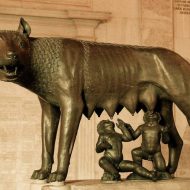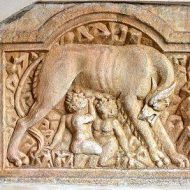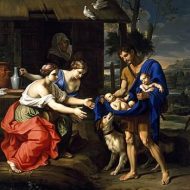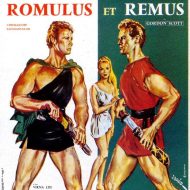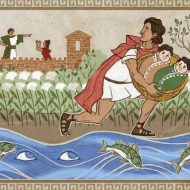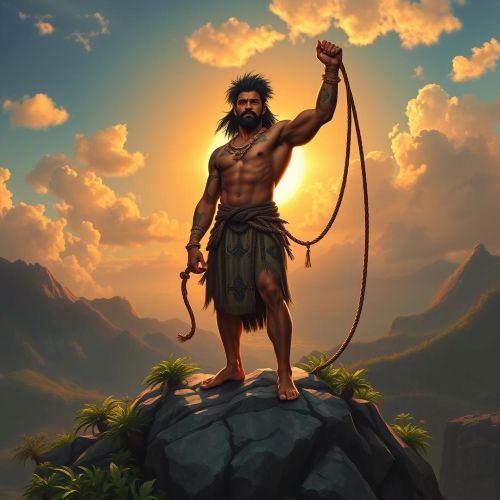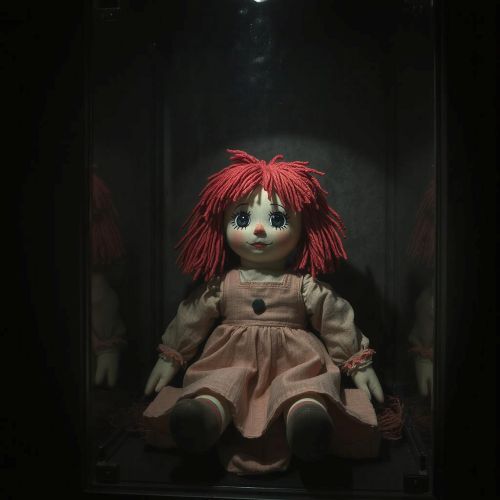Romulus & Remus : The Founding Fathers
Listen
At a glance
| Description | |
|---|---|
| Origin | Roman Mythology |
| Classification | Mortals |
| Family Members | Rhea (Mother), Numitor (Father) |
| Region | Italy |
| Associated With | Rome |
Romulus & Remus
Introduction
In Roman mythology, the twin brothers Romulus and Remus created the city of Rome. The killing of Remus by his twin, along with other tales from their story, have inspired artists throughout the ages. Since ancient times, the image of a she-wolf suckling the twins has been a symbol of the city of Rome and the ancient Romans. The story of the twin brothers is believed to have been told before the founding of Rome. This is because the earliest written account of the myth dates back to the 3rd century BC.
The pair were the children of Mars and Rhea, and their story is often told by authors such as Virgil wherein they were born to create Rome. Modern scholarship approaches the stories of Romulus and Remus, with the retelling being based on the various versions presented by Roman historians. Other narratives suggest that these are popular or folkloric traditions, while some remain inscrutable in their meanings.
Physical Traits
They were often described by poets and painters to be well built, tall and had the classic physical features of the classical Mediterranean man. They had dark curly hair and physically dominant in stature.
Family
They are descendants of Aeneas, who were responsible for discovering Italy. Romulus and Remus were related to Aeneas through Numitor, who was the king of Alba Longa and their mother’s father. Before they were conceived, his reign was usurped by Amulius, who was the brother of Mars.
Amulius inherited the treasury of Alba Longa from Numitor. He wanted to avoid a conflict of power, so he killed the male heirs of Numitor and forced Rhea to become a Vestal Virgin. Vestal Virgins were priestesses of Vesta, patron goddess of the hearth; they were charged with keeping a sacred fire that was never to be extinguished and to take vows of chastity.
Some legends suggest that Mars appeared and laid with Rhea, while others suggest that Hercules was her partner. It is also possible that she was raped by an unknown man, and that she gave birth to her sons. It was custom for a Vestal Virgin to be condemned to death if she betrayed her vows, however, since Amulius feared the wrath of Hercules or Mars, he did not want to stain his hands with the blood of her children.
Amulius ordered the execution of the twin brothers by throwing them into the Tiber River. He believed that since they would die without being killed by the sword, they would be spared from punishment by the gods. He ordered a servant to carry out the death sentence, but in every scenario of this myth, the servant takes pity on the twins and spares their lives. The servant, then, places the twins into a basket onto the River Tiber, and the river carries the boys to safety.
Other Names
Being characters that were exclusive to the Roman mythology and among the few characters that were not influenced by the Greeks, they do not have any alternate names. The city of Rome was named after the victorious brother Romulus who fought with his brother over the location of the new city.
Powers and Abilities
The twins were not blessed with any powers or super human capabilities. They however had established themselves as leaders with the command over the people within their armies.
Modern Day Influence
The story of Romulus and Remus have been told and retold from various perspectives in modern cinema, television and have inspired numerous books and novels. There have been claims that the biblical story of Cain and Able was heavily inspired by the legend of Romulus and Remus.
Related Images
Frequently Asked Questions
What is the story of Romulus and Remus?
The legend of Romulus and Remus is central to the founding myth of Rome. According to legend, they were twin brothers born to Rhea Silvia, a Vestal Virgin, and the god Mars. Abandoned and left to die, they were discovered and nursed by a she-wolf. As they grew older, Romulus and Remus decided to establish a city, but a dispute over its location led to Romulus killing Remus. Romulus then went on to found the city of Rome, naming it after himself. This myth serves as an origin story for the city of Rome and underscores its significance in ancient Roman culture and history.
Why was Romulus and Remus abandoned?
In the mythological tale of Romulus and Remus, they were abandoned due to a series of events surrounding their mother, Rhea Silvia. Rhea Silvia was a Vestal Virgin, sworn to celibacy, and her pregnancy with twins violated her sacred vows. Additionally, their father was believed to be Mars, the god of war, adding further scandal to their birth. To avoid punishment or repercussions, Rhea Silvia’s uncle, King Amulius, ordered the twins to be abandoned, casting them into the Tiber River. Thus, the twins were abandoned as a result of the circumstances surrounding their birth and the desire to avoid scandal and maintain order within the kingdom.
Who is older Romulus or Remus?
According to the Roman mythological tradition, Romulus and Remus were twins, and there is no definitive account of which one was born first. They are typically depicted as being of equal age, born at the same time from the same mother, Rhea Silvia, making their status as twins central to their story and the founding myth of Rome.
What is the story of the wolf in Rome?
The story of the wolf in Rome revolves around Romulus and Remus, legendary founders of the city. Nursed by a she-wolf after being abandoned, they survived infancy to establish Rome, making the she-wolf a symbol of the city’s origins and resilience.
Who was Rome's first king?
According to Roman mythology and tradition, Rome’s first king was Romulus. He was one of the legendary twin brothers Romulus and Remus, who are said to have founded the city of Rome. After a dispute over where to establish the city, Romulus killed Remus and became the sole ruler, thus becoming Rome’s first king and the city’s namesake.

